In an era where technology and consumer demands are rapidly evolving, the landscape for commercial panini press manufacturers is brimming with opportunities and challenges. As we look ahead to the next decade, it’s crucial to understand the dynamics that will shape the industry, from the innovation driving product development to the strategies that will secure a competitive edge. This discussion delves into the multifaceted realm of challenges and opportunities facing manufacturers, highlighting the factors that will determine their success in the years to come.
The Growing Demand for Commercial Panini Presses
The surge in demand for commercial panini presses has been nothing short of remarkable. As the world’s culinary landscape continues to evolve, these versatile appliances have become a staple in the fast-casual and quick-service restaurant (QSR) industries. The convenience and efficiency they offer in preparing delicious panini sandwiches have propelled their popularity, making them a must-have for any establishment aiming to cater to the growing number of sandwich enthusiasts.
The demand for commercial panini presses is driven by several factors. For one, the rise of health-conscious consumers has led to an increased interest in grab-and-go meals that are both nutritious and satisfying. Panini sandwiches, with their variety of ingredients and customizable options, fit this trend perfectly. Additionally, the ease of use and consistent output of these presses ensure that restaurants can serve high-quality sandwiches at a rapid pace, keeping lines short and customer satisfaction high.
In Europe, the love for sandwiches is deeply rooted in the culture, with countries like Italy and France being synonymous with culinary excellence. This has translated into a significant demand for commercial panini presses, as businesses strive to capture the essence of these traditional sandwiches in their own offerings. The ability to toast, grill, and melt cheese simultaneously adds a unique texture and flavor profile that sets panini apart from other sandwich options.
Similarly, in the United States, the demand for commercial panini presses has been on the rise. The QSR industry, which includes everything from fast-food chains to gourmet cafes, has embraced the panini as a menu staple. The versatility of the panini press allows for the creation of a wide array of sandwiches, from classic ham and cheese to gourmet combinations with avocado and pesto. This has made the appliance a favorite among chefs and restaurant owners alike.
The technological advancements in commercial panini presses have also played a crucial role in their growing demand. Modern presses come with features like adjustable heat settings, non-stick surfaces, and programmable cooking times, which ensure that each sandwich is cooked to perfection. These innovations have not only improved the quality of the end product but have also made the cooking process more user-friendly and efficient.
Another factor contributing to the demand for commercial panini presses is the rise of food trucks and pop-up restaurants. These mobile businesses often rely on compact and portable equipment, and the panini press fits this criterion perfectly. Its ability to produce high-quality sandwiches in a small space has made it an essential tool for entrepreneurs looking to start their own food business.
The global trend of convenience and the need for quick service have also fueled the demand for commercial panini presses. As consumers seek faster alternatives to traditional meals, the ability to serve a hot, freshly toasted sandwich in minutes is highly appealing. This has led to an increase in orders for these presses from not just restaurants, but also from schools, hospitals, and airports, where the convenience factor is paramount.
Moreover, the rise of social media and food blogs has brought the panini sandwich into the spotlight. With countless recipes and cooking techniques shared online, the panini has become a trendy item that restaurateurs and chefs are eager to incorporate into their menus. This has, in turn, increased the demand for commercial panini presses as businesses strive to keep up with the latest food trends.
Despite the growing demand, the market for commercial panini presses is not without its challenges. Competition from other sandwich-making appliances, such as toasters and grills, remains a concern. However, the unique combination of toasting, grilling, and melting cheese that the panini press offers continues to set it apart from other options.
In conclusion, the demand for commercial panini presses is a testament to the evolving culinary landscape and the changing preferences of consumers. As long as there is a desire for convenient, high-quality sandwiches, the demand for these versatile appliances is likely to remain strong. The future of commercial panini presses looks bright, with continued innovation and a growing market in both Europe and the United States.
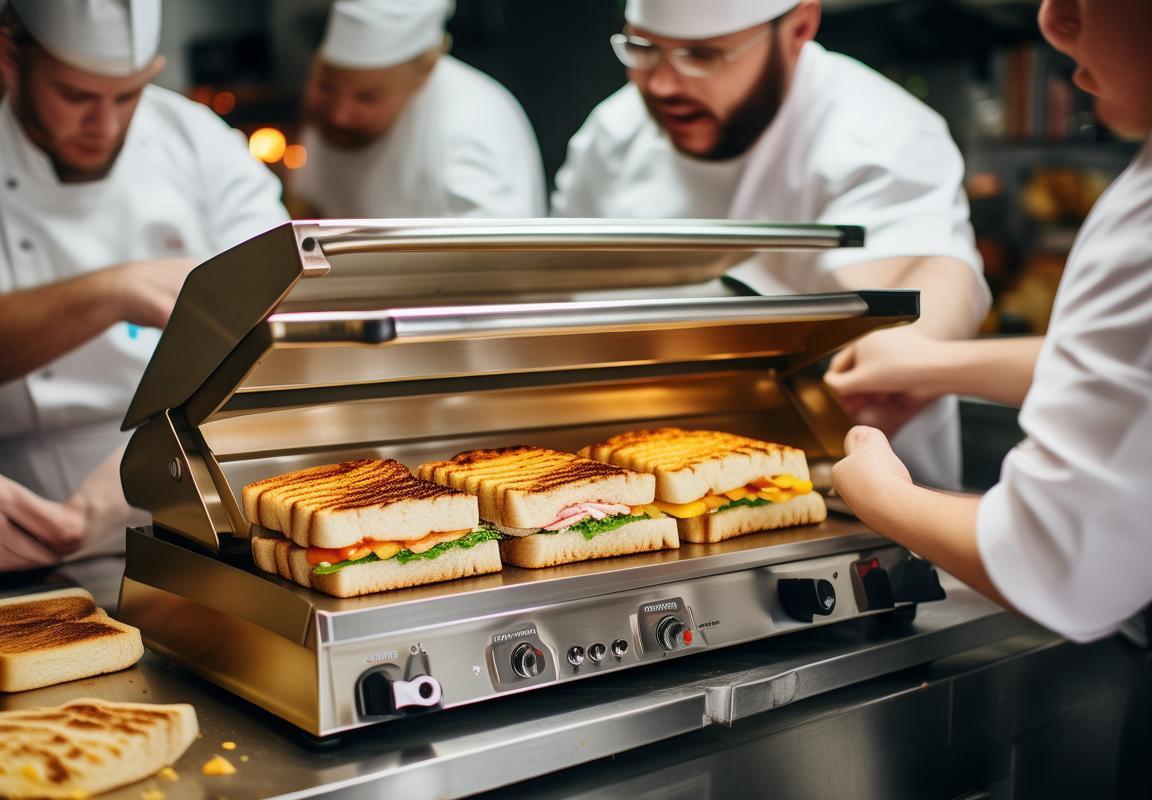
Market Overview in the European and American Sectors
The European market for commercial panini presses has seen a surge in demand, driven by a strong culinary culture and a growing preference for fast, high-quality food options. Italy, in particular, is renowned for its love of sandwiches, and this has translated into a robust demand for commercial-grade panini presses. These devices are not just limited to sandwich shops but have also found their way into cafes, restaurants, and even stadiums, where quick service is a must.
In the United States, the market for commercial panini presses is equally vibrant, though the demand is slightly different. Americans are more likely to associate panini presses with gourmet and artisanal food trends. As a result, there’s a higher concentration of these presses in gourmet markets, food trucks, and upscale cafes. The convenience and versatility of these machines have made them a staple in the fast-casual dining sector.
In Europe, the preference for panini presses often leans towards models that offer a variety of heating elements and adjustable temperature controls. This is due to the diverse range of breads and fillings used in European cuisine, from the dense ciabatta to the thin, crispy baguettes. The ability to customize the cooking experience is crucial for chefs looking to replicate traditional European flavors.
In the American market, while the same level of customization is appreciated, there’s also a significant demand for machines that can handle a high volume of orders quickly. The fast-paced lifestyle in the U.S. has led to a preference for panini presses that can cook multiple sandwiches simultaneously, ensuring that lines don’t form at the counter.
The technological advancements in commercial panini presses have not gone unnoticed. Smart features such as digital temperature controls, non-stick surfaces, and programmable settings are becoming standard in both European and American markets. These features not only enhance the cooking experience but also make maintenance and cleaning easier for busy kitchens.
When it comes to the types of commercial panini presses available, there’s a wide array of options. From countertop models to conveyor ovens, the variety caters to different kitchen layouts and needs. In Europe, there’s a preference for countertop presses that are compact and can be easily moved around, while in the U.S., there’s a trend towards larger, more industrial-looking presses that can handle high-traffic environments.
The European market is also seeing an increase in eco-friendly and energy-efficient panini presses. With a growing focus on sustainability, manufacturers are responding by producing presses that consume less energy and are made from recyclable materials. This shift aligns with the broader European commitment to reducing carbon footprints in the foodservice industry.
In the American sector, the focus on health and wellness has influenced the demand for panini presses that can cook food with minimal oil or fat. This has led to an interest in models that offer air frying capabilities, as well as those with adjustable cooking temperatures to control the level of crispiness.
The distribution channels for commercial panini presses in both Europe and the U.S. are diverse, ranging from direct sales to manufacturers to partnerships with wholesale suppliers. In Europe, there’s a strong presence of specialized equipment retailers, while in the U.S., the market is more fragmented, with a mix of online marketplaces, trade shows, and direct sales through distributors.
The competitive landscape in both markets is characterized by well-established brands that have been around for decades, as well as newer entrants bringing innovative technologies and design to the table. In Europe, the market is dominated by a few key players, while in the U.S., there’s a more varied landscape with both domestic and international brands competing for market share.
As the demand for commercial panini presses continues to grow, so too does the need for ongoing training and support for operators. Manufacturers are responding by offering comprehensive service packages, including training workshops and maintenance services, to ensure that their customers get the most out of their equipment.
The market for commercial panini presses in both Europe and the U.S. is dynamic and evolving, with a focus on innovation, efficiency, and customer satisfaction. As consumers continue to seek out unique and high-quality food experiences, the role of the commercial panini press in the foodservice industry is set to remain central.
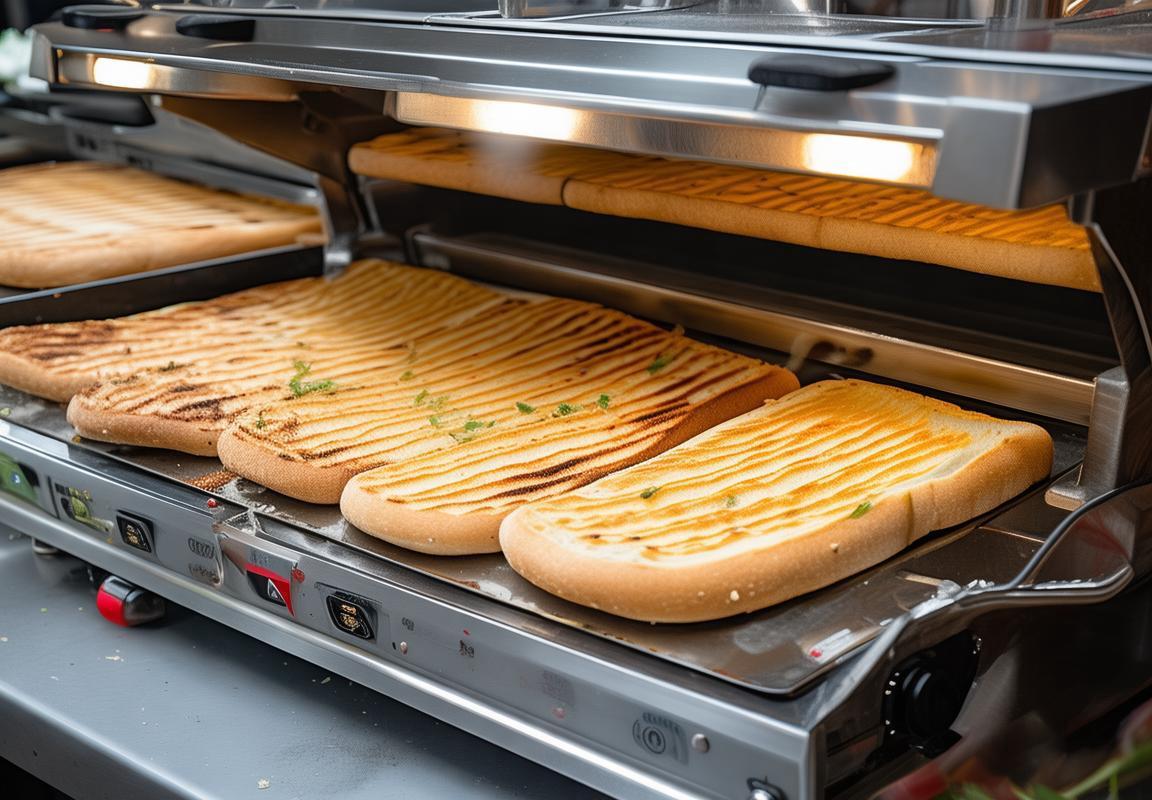
Key Features and Technologies in Commercial Panini Presses
Commercial panini presses have seen a surge in popularity, driven by a demand for quick, convenient, and delicious food options. These appliances are not just for the casual user at home; they have become a staple in the commercial kitchen landscape. Here’s a delve into the key features and technologies that set these presses apart:
-
Even Heat Distribution: One of the most crucial features of a commercial panini press is its ability to distribute heat evenly across the grill plates. This ensures that every piece of bread or sandwich is toasted to perfection without any cold spots or burnt areas.
-
Variable Temperature Control: Modern commercial panini presses often come with adjustable temperature settings. This allows chefs to tailor the cooking temperature to different types of bread and fillings, ensuring that each item is cooked to the desired crispness.
-
Non-Stick Surfaces: To make cleaning easier and to prevent food from sticking, many commercial presses are equipped with non-stick surfaces. This feature is particularly important in high-volume kitchens where quick and efficient cleaning is a necessity.
-
Safety Locks and Interlocks: For safety reasons, commercial presses often have locks and interlocks that prevent the unit from operating unless it is securely closed. This is a crucial feature to prevent accidental burns and to ensure that the appliance is only used when in use.
-
Quick Release Mechanisms: To enhance efficiency, some models come with quick release mechanisms that allow for easy opening and closing of the press. This feature is especially useful in a fast-paced kitchen where time is of the essence.
-
Digital Temperature Display: Many commercial panini presses now feature digital temperature displays, which provide precise control over the cooking process. This helps chefs to maintain consistency and quality in their output.
-
Removable Plates for Easy Cleaning: Some models offer removable grill plates, which can be easily washed in a dishwasher. This feature is not only convenient but also ensures that the appliance stays clean and hygienic.
-
Automatic Shut-Off: To prevent overheating and potential fires, many commercial presses are designed with an automatic shut-off feature. This safety mechanism turns off the appliance after a certain period of inactivity or when the temperature reaches a predetermined level.
-
Large Grilling Surface: Commercial panini presses often come with larger grilling surfaces compared to residential models. This allows for the preparation of multiple sandwiches at once, increasing efficiency in busy kitchens.
-
Steam Functionality: Some advanced models include a steam function, which can be used to add moisture to the cooking process, especially beneficial for items like paninis with moist fillings.
-
Programmable Settings: For added convenience, some presses offer programmable settings that allow users to save their preferred cooking temperatures and times. This is especially useful for establishments with a signature menu that requires consistent preparation.
-
Built-in Timer: A built-in timer can be a game-changer in a commercial kitchen. It allows chefs to monitor the cooking time for each sandwich, ensuring that every item is cooked to the perfect level of doneness.
-
Easy to Use Interface: Modern commercial panini presses are designed with user-friendly interfaces, making them simple to operate. This is particularly important in a kitchen environment where staff may have varying levels of experience.
-
Stainless Steel Construction: The durability and hygiene of the appliance are enhanced by the use of stainless steel in its construction. This material is resistant to corrosion and easy to clean, making it a popular choice for commercial kitchens.
-
Energy Efficiency: With the growing focus on sustainability, some commercial panini presses are designed to be energy-efficient, reducing utility costs and minimizing the environmental impact.
These features and technologies in commercial panini presses not only enhance the quality of the food being served but also streamline the workflow in commercial kitchens, making them an essential tool for businesses looking to offer a wide variety of toasted sandwiches.
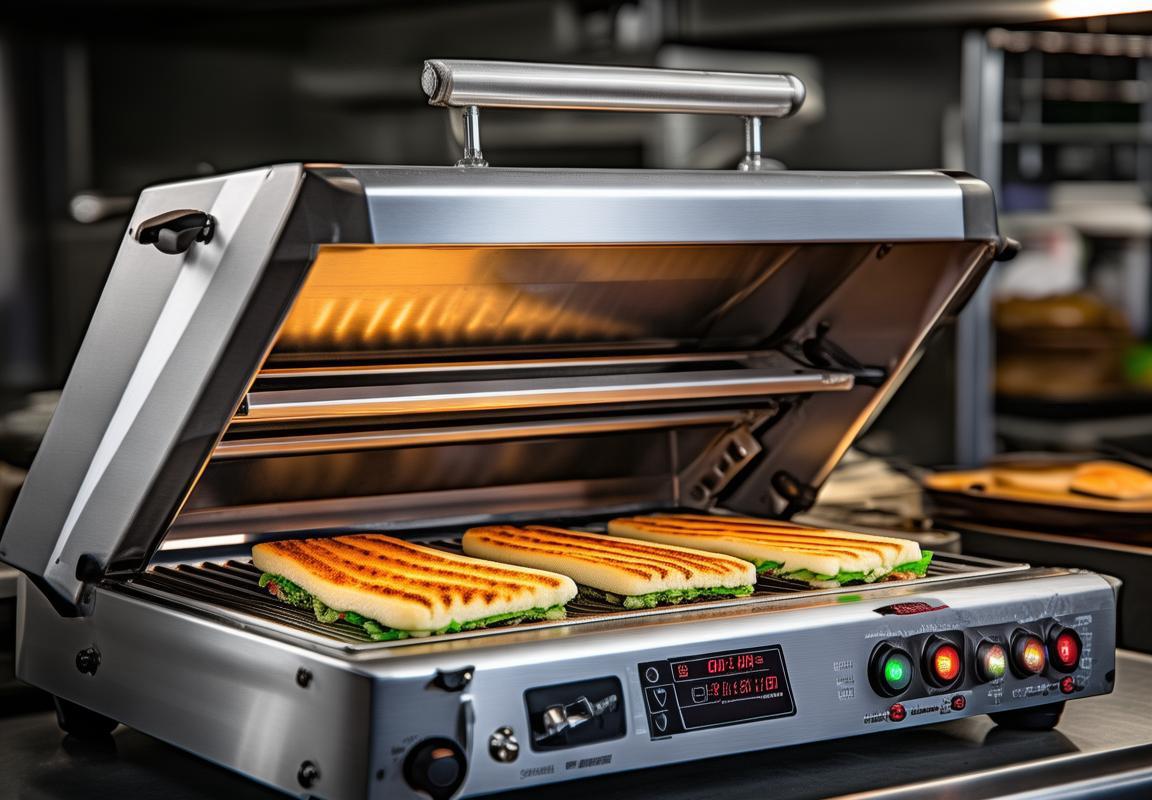
Top Players in the Commercial Panini Press Market
In the bustling commercial panini press market, several key players have established themselves as industry leaders, each bringing their unique strengths and innovations to the table. Here’s a glimpse into the profiles of some of these top players:
-
Breville has long been a household name in kitchen appliances, and their commercial panini presses are no exception. Known for their sleek designs and high-quality materials, Breville offers a range of presses that cater to both professional chefs and food service operators. Their products often feature advanced heating elements and non-stick surfaces that ensure consistent and easy-to-clean performance.
-
Cuisinart has a strong presence in the commercial kitchen equipment market, with their panini presses being a favorite among many. Cuisinart’s commercial models are designed for durability and efficiency, with features like adjustable heat settings and rapid heat-up capabilities. Their commitment to innovation is evident in their constant introduction of new technologies that enhance the cooking experience.
-
Hamilton Beach is another brand that has made a name for itself in the commercial panini press sector. Their presses are known for their affordability without compromising on quality. Hamilton Beach offers a variety of sizes and styles, making them a versatile choice for different types of foodservice operations. The brand’s focus on user-friendliness and safety features has won over many customers.
-
Sunbeam has a legacy of creating reliable kitchen appliances, and their commercial panini presses are no different. These presses are designed to withstand the rigors of high-volume use, with sturdy construction and reliable heating elements. Sunbeam’s commitment to sustainability is also reflected in their energy-efficient models, which are both cost-effective and environmentally friendly.
-
West Bend is a brand that’s well-respected for its commercial appliances, and their panini presses are no less impressive. West Bend offers a range of presses that are perfect for use in delis, cafes, and restaurants. Their products are known for their even heating and ability to cook a variety of foods, from sandwiches to pizzas, with ease.
-
Nesco has a niche but significant presence in the commercial panini press market. They specialize in compact and portable models that are ideal for small businesses or for use in events and catering services. Nesco’s presses are often praised for their ease of use and ability to produce high-quality paninis in a short amount of time.
-
Doyon is a brand that has gained popularity for its commercial-grade panini presses. Their products are designed with the busy professional in mind, offering features like rapid heat recovery and precise temperature control. Doyon’s presses are often chosen for their ability to handle continuous use without losing performance.
-
Proctor-Silex has a reputation for producing commercial appliances that are both durable and easy to maintain. Their panini presses are a testament to this reputation, with features like heavy-duty components and intuitive controls. Proctor-Silex’s focus on providing value to the customer is clear in their competitive pricing and robust warranties.
-
Chef’s Choice is a brand that’s known for its precision and innovation in kitchen tools, and their commercial panini presses are no different. These presses are often preferred by chefs for their ability to cook a variety of foods to perfection. Chef’s Choice offers a range of models with different capabilities, ensuring there’s something for every type of kitchen.
-
Cuisipro has made a mark in the commercial panini press market with their focus on professional-grade performance at a reasonable price. Their presses are well-suited for both front-of-house and back-of-house operations, with features that make them a reliable choice for busy kitchens.
These top players in the commercial panini press market have each carved out their own niche, offering a wide range of products that cater to different needs and preferences. Whether it’s about speed, efficiency, or versatility, these brands have positioned themselves as go-to solutions for commercial kitchens worldwide.
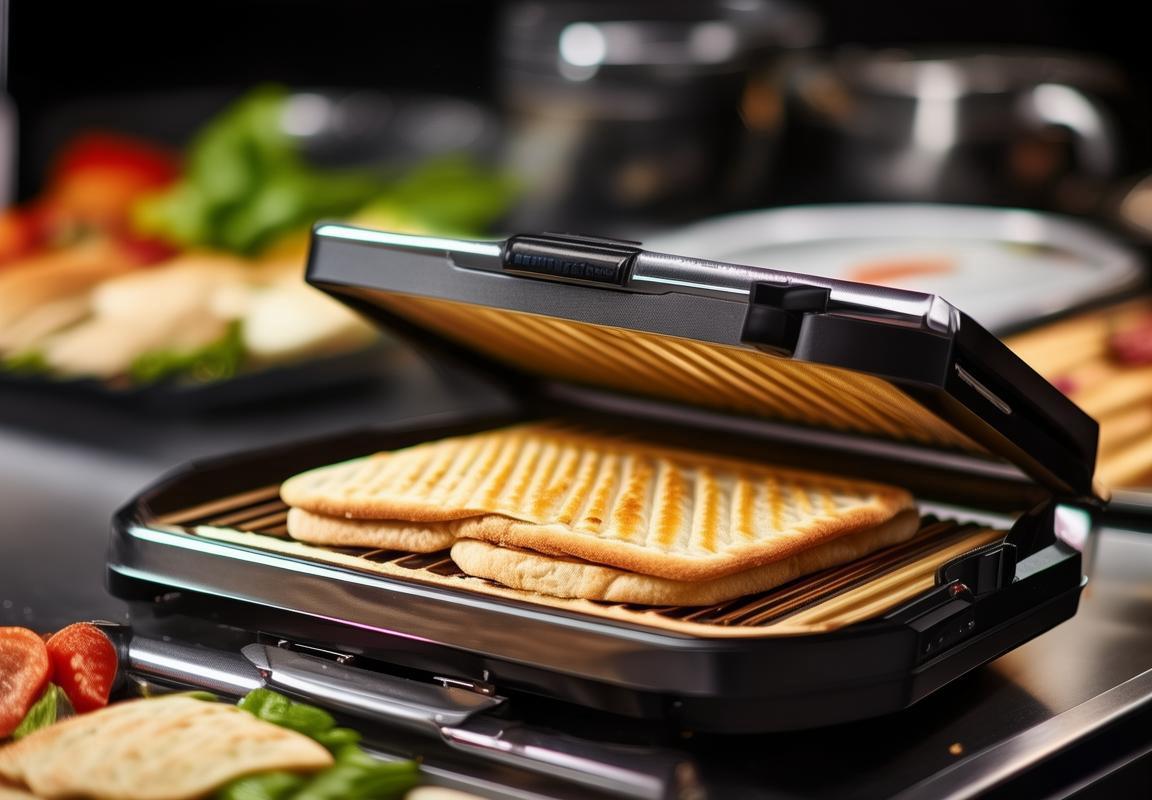
The Impact of the Pandemic on Sales and Production
The COVID-19 pandemic has reshaped industries worldwide, and the commercial panini press market is no exception. The impact on sales and production has been profound, with several notable effects:
Sales DynamicsAs lockdowns and social distancing measures were implemented, the demand for quick and convenient food options surged. Consumers sought out alternatives to dining out, leading to a significant increase in the sales of commercial panini presses. The ease of use and the ability to create restaurant-quality sandwiches at home became highly attractive. However, the initial supply chain disruptions caused a temporary dip in sales as manufacturers struggled to keep up with the sudden surge in demand.
Supply Chain DisruptionsThe pandemic’s global reach disrupted supply chains, affecting the production of commercial panini presses. Many manufacturers rely on components from various countries, and travel restrictions and factory closures led to delays in the production process. This, in turn, impacted the availability of products in the market, with some retailers experiencing shortages and longer wait times for restocking.
Shift in Consumer BehaviorThe pandemic accelerated the adoption of online shopping, and this shift had a direct impact on the sales of commercial panini presses. Consumers turned to e-commerce platforms for their purchases, leading to a significant increase in online sales. This shift also meant that manufacturers had to adapt quickly to meet the new distribution channels and customer expectations for fast shipping and reliable delivery.
Innovation and AdaptationTo counter the challenges posed by the pandemic, several key players in the commercial panini press market innovated and adapted their production processes. They focused on streamlining operations, reducing waste, and improving efficiency. Some manufacturers even shifted production lines to produce essential items, such as personal protective equipment (PPE), before returning to their core products.
Economic UncertaintyThe economic uncertainty caused by the pandemic led to cautious spending among both consumers and businesses. While sales of high-end commercial panini presses remained stable, there was a noticeable drop in demand for mid-range and budget-friendly models. This trend reflected the broader economic climate, where consumers and businesses prioritized essential purchases over luxury items.
Government Support and Stimulus PackagesIn many regions, governments implemented support packages to help businesses recover from the pandemic’s impact. These included financial aid, tax relief, and grants, which helped some commercial panini press manufacturers to sustain their operations and invest in new technologies or expansions.
Market DiversificationTo mitigate the risks associated with a single market, some manufacturers diversified their product lines and target markets. They explored opportunities in emerging markets and countries with growing demand for fast casual dining options. This diversification helped to stabilize sales and reduce reliance on any single market segment.
Long-Term Changes in the IndustryThe pandemic has also led to long-term changes in the commercial panini press industry. There’s an increased focus on hygiene and safety features in new products, as well as a push for more energy-efficient and sustainable designs. Additionally, the rise of contactless payments and delivery options has prompted manufacturers to consider integrating these technologies into their products and services.
Consumer SentimentThe pandemic has also influenced consumer sentiment, with a growing preference for healthier and home-cooked meals. This shift has opened up opportunities for manufacturers to develop healthier panini press options, such as those that can cook vegetables or whole grains, appealing to a more health-conscious consumer base.
In conclusion, the pandemic has had a multifaceted impact on the sales and production of commercial panini presses. While it presented significant challenges, it also spurred innovation, adaptation, and long-term changes that could reshape the industry for years to come.
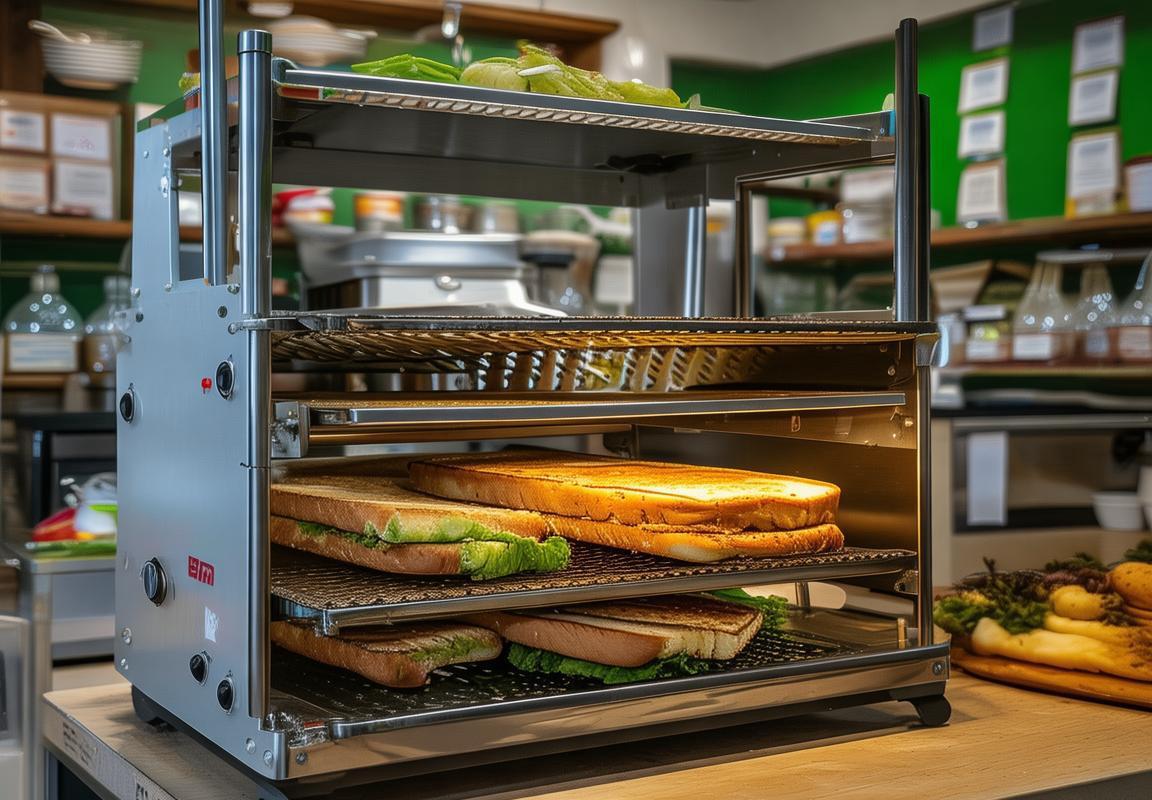
Consumer Trends and Preferences in the US and Europe
The shift towards healthier eating habits has significantly influenced consumer preferences in both the United States and Europe. Fast-casual restaurants have gained popularity, and with them, a demand for healthier, customizable food options like panini sandwiches.
In the US, there’s a noticeable trend towards gourmet and artisanal food, with consumers seeking unique and high-quality ingredients. This has led to a preference for panini presses that not only deliver perfect grill marks but also offer versatility in terms of cooking different types of bread and ingredients.
European consumers, on the other hand, are more focused on sustainability and environmental friendliness. This preference is reflected in the demand for commercial panini presses that are energy-efficient and made with eco-friendly materials. The rise of organic and locally sourced ingredients has also become a driving force in the market.
The convenience factor plays a crucial role in both regions. Busy lifestyles have led to a surge in demand for quick, yet satisfying meals that can be easily prepared using commercial panini presses. This has resulted in a preference for compact and easy-to-use machines that can be integrated into various settings, from cafes to delis.
In the US, there’s a strong emphasis on technology integration. Consumers are increasingly interested in panini presses that come with digital controls, allowing for precise temperature adjustments and timer settings. This focus on technology is also evident in the popularity of smart appliances that can be controlled remotely through smartphones.
European consumers, while also valuing technology, place a higher priority on the craftsmanship and durability of the appliances. High-quality, long-lasting panini presses are sought after, often with features like adjustable pressure control, which can cater to a variety of bread types and thicknesses.
In both the US and Europe, there’s a growing segment of health-conscious consumers who are interested in panini presses that can cook ingredients like lean proteins, vegetables, and whole grains, promoting a balanced diet. This segment has led to the development of panini presses with non-stick surfaces that minimize the need for added fats and oils.
The rise of food trucks and pop-up markets has also impacted consumer preferences. These mobile food vendors need portable, easy-to-clean panini presses that can withstand the rigors of on-the-go operations. The demand for such appliances has spurred manufacturers to create compact, yet robust models that can maintain consistent cooking performance.
In terms of flavor profiles, American consumers are exploring international cuisines, leading to a preference for panini presses that can handle a variety of spices and marinades. This has opened up a market for machines that can withstand high temperatures without burning the food.
European consumers, while open to international flavors, tend to stick to more traditional and authentic recipes. As such, they seek panini presses that can deliver the perfect balance of grill marks and moisture without compromising the integrity of the ingredients.
The customization trend is also prominent in both regions. Consumers are looking for panini presses that can accommodate various sizes of bread and different types of fillings, allowing them to create personalized meals. This has led to the development of machines with adjustable plates and heating elements.
In conclusion, consumer trends and preferences in the US and Europe are diverse and evolving. From a focus on health and sustainability to convenience and technology, the commercial panini press market is responding to a wide range of needs and desires. As these trends continue to shape the industry, manufacturers must stay attuned to the changing landscape to meet the demands of their customers.
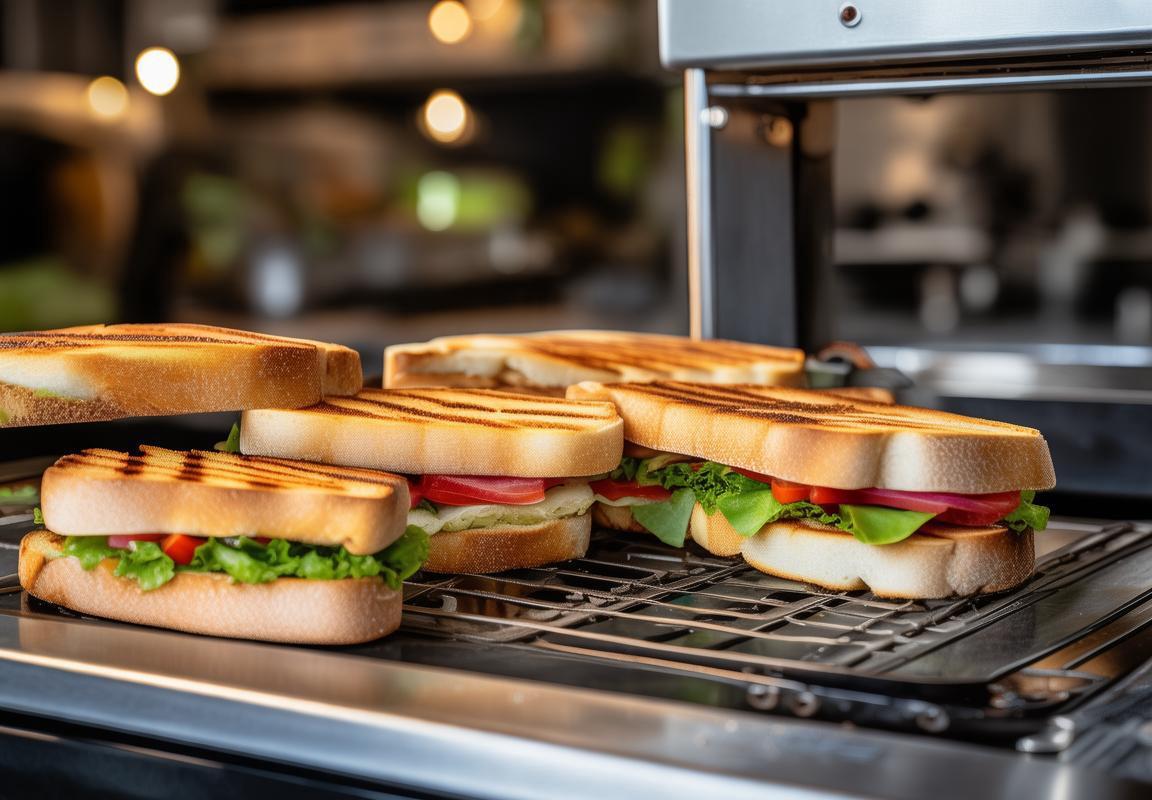
Distribution Channels and Retail Strategies
In the competitive landscape of commercial panini presses, the distribution channels and retail strategies play a pivotal role in reaching the end consumer. Here’s an exploration of how these channels and strategies are shaping the market:
Retailers have increasingly embraced e-commerce platforms, offering a convenient and accessible way for customers to purchase commercial panini presses. Online marketplaces like Amazon and eBay have become go-to destinations, allowing brands to tap into a vast customer base without the need for a physical retail presence.
Specialized kitchen equipment stores have also become key players in the distribution game. These stores cater to the specific needs of commercial kitchens, ensuring that the panini presses they offer are not only of high quality but also tailored to the demands of professional cooking environments.
Brands have started to leverage social media and influencer partnerships to showcase their commercial panini presses. By partnering with chefs and food bloggers, companies can reach a wider audience through engaging content, which often leads to increased sales and brand visibility.
Direct-to-consumer (DTC) models have gained traction, especially among newer brands. By selling directly to customers, these companies can maintain better control over the customer experience and gather valuable feedback that can be used to improve their products and services.
Trade shows and industry events have always been important for networking and showcasing products. However, with the pandemic, virtual trade shows have become a popular alternative, allowing manufacturers to reach a global audience without the logistical hurdles of in-person events.
Wholesale distribution remains a cornerstone of the commercial panini press market. Distributors play a crucial role in getting products to a wide range of retailers, including independent stores, large chain supermarkets, and specialty shops.
The rise of subscription services has also influenced the distribution landscape. Some brands are offering monthly or quarterly subscription boxes that include a variety of kitchen gadgets, including commercial panini presses, which can be delivered directly to the consumer’s doorstep.
In-store demonstrations have become a powerful tool for retailers. By allowing customers to see and experience the product firsthand, retailers can boost sales and build trust in the brand. This approach is particularly effective for high-value items like commercial-grade appliances.
Cross-selling and bundling strategies are also employed by retailers. By offering panini presses alongside other kitchen equipment or accessories, they can encourage customers to make additional purchases, thus increasing average order values.
Marketing strategies have evolved to include a mix of traditional and digital channels. Email marketing campaigns, targeted ads, and SEO efforts are all part of the toolkit used to attract and retain customers.
Customer service and support are critical components of retail strategies. Offering after-sales service, such as installation assistance or troubleshooting guides, can help build long-term customer relationships and foster brand loyalty.
The pandemic has accelerated the adoption of contactless and curbside pickup options. Retailers who have adapted to these new shopping habits have seen increased customer satisfaction and retention.
Lastly, the emphasis on sustainability and eco-friendly practices has influenced distribution and retail strategies. Brands and retailers are increasingly looking for ways to reduce their carbon footprint and offer products that align with these values, which can also be a selling point with environmentally conscious consumers.
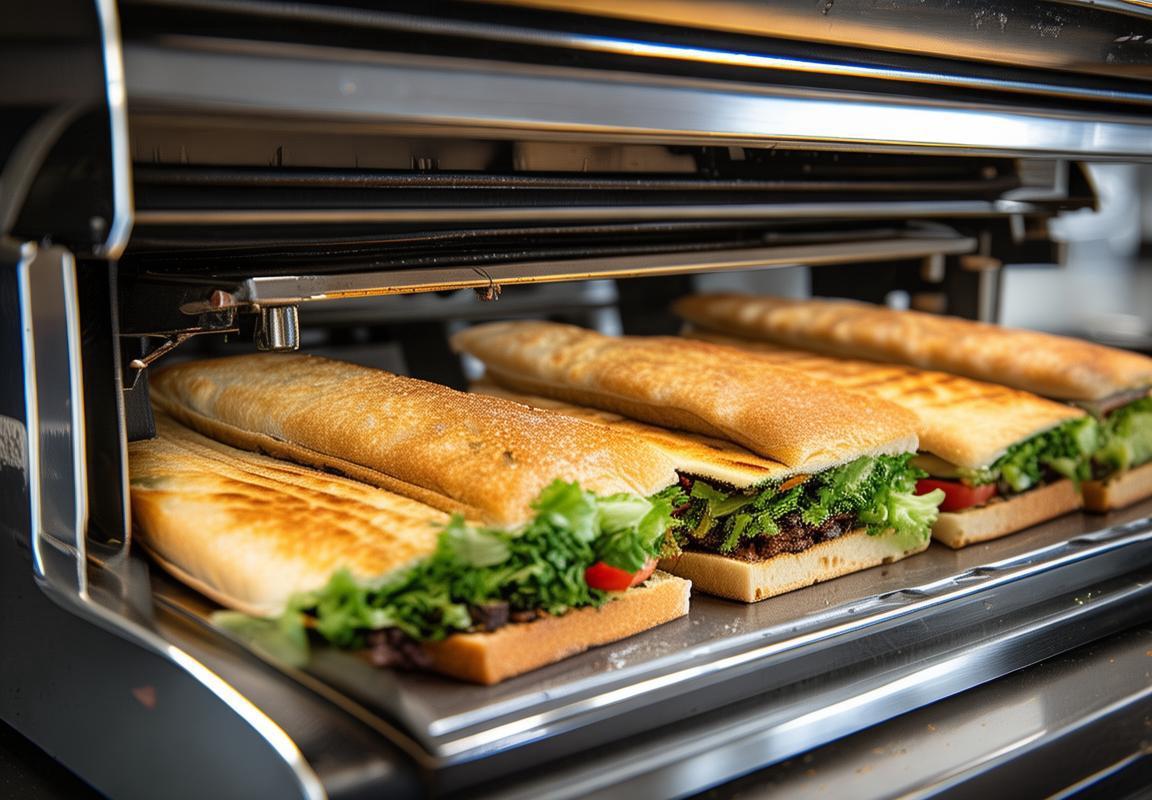
Innovation and Future Outlook for Commercial Panini Press Manufacturers
The evolution of commercial panini presses has been marked by a relentless pursuit of innovation, and as the market continues to grow, manufacturers are looking towards the future with a blend of optimism and strategic planning. Here’s a glimpse into the innovations and future outlook for commercial panini press manufacturers:
The integration of smart technology has become a cornerstone in the commercial panini press industry. Devices are now equipped with digital controls that allow for precise temperature adjustments and timing, ensuring consistent results every time. Users can program their favorite settings, and some models even offer Bluetooth connectivity, allowing for remote operation and monitoring.
Sustainability is no longer just a buzzword but a critical factor in product development. Manufacturers are focusing on eco-friendly materials and energy-efficient designs. The use of recycled steel and non-toxic coatings is becoming more prevalent, catering to a consumer base that values environmental responsibility.
The compact size of modern commercial panini presses is a testament to the industry’s commitment to versatility. These appliances can now fit seamlessly into various settings, from busy cafes to food trucks, without compromising on performance. The trend towards portability is expected to continue, with manufacturers exploring foldable and lightweight designs.
Customization is key in the commercial panini press market. Consumers are seeking products that not only meet their functional needs but also reflect their brand identity. As a result, manufacturers are offering a range of options, from different heating elements to unique design aesthetics, allowing businesses to create a signature look for their panini stations.
The rise of health-conscious consumers has spurred the development of healthier panini press options. Non-stick surfaces have become standard, reducing the need for oil and fat, while new materials are being tested to further minimize the release of harmful chemicals during cooking. The market is seeing an increase in models designed for vegan and gluten-free diets, reflecting the growing demand for healthier eating options.
The integration of social media and online platforms has changed how manufacturers market their products. Visual content, such as high-quality images and videos, is crucial in showcasing the capabilities of new panini presses. Influencer partnerships and online demonstrations are becoming more common, providing a direct line of communication between manufacturers and potential customers.
As the world becomes more interconnected, the global market for commercial panini presses is expanding. Manufacturers are looking to international markets to diversify their sales channels. Exporting is not just about finding new customers; it’s also about adapting to different cultural preferences and regulatory standards.
The rise of e-commerce has revolutionized the retail landscape. Online stores offer a convenient way for businesses to purchase commercial panini presses without the need for physical visits to stores. Manufacturers are investing in user-friendly e-commerce platforms and optimizing their websites for mobile devices, ensuring a seamless shopping experience.
The future of commercial panini press manufacturing is likely to be driven by the Internet of Things (IoT). Imagine a panini press that can alert you when it’s time to restock ingredients, or one that can connect to your kitchen management system to provide analytics on usage and performance. IoT integration is expected to lead to more efficient operations and improved customer service.
Innovation in cooking technology is also on the horizon. Some manufacturers are exploring the use of induction heating, which offers faster and more precise temperature control. Others are experimenting with new materials that could potentially change the way commercial panini presses are constructed and maintained.
Finally, the future of commercial panini press manufacturing hinges on the ability to anticipate and adapt to changing consumer trends. As the industry continues to evolve, manufacturers must remain agile, embracing new technologies and market dynamics to stay ahead of the curve. The path forward is one of continuous improvement and strategic foresight.
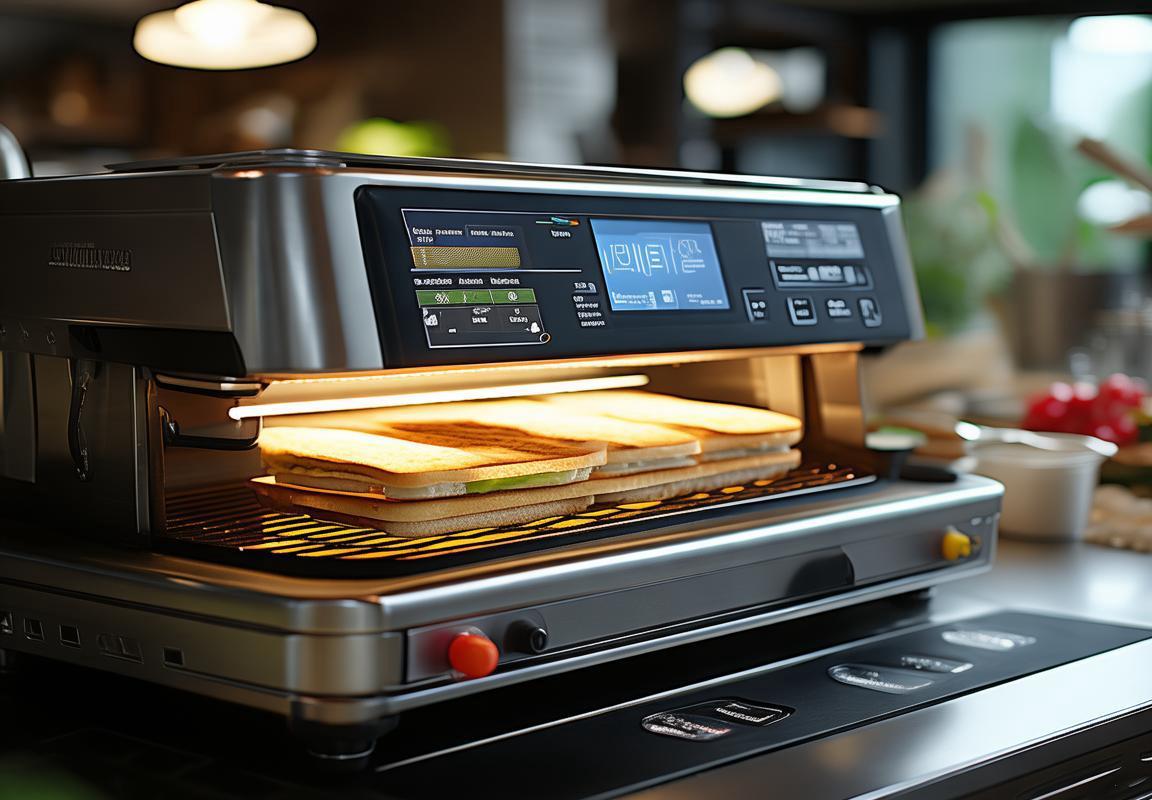
Case Studies: Successful Implementations of Commercial Panini Presses
In the bustling streets of New York City, the introduction of a sleek commercial panini press at a popular café revolutionized the menu. The press quickly became a hit, offering patrons a convenient and delicious option for a quick, customizable meal. The café owners noticed a surge in sales, especially during lunch hours, and attributed the success to the versatility and ease of use of the panini press.
At a trendy food truck in London, the owner decided to incorporate a commercial panini press into their mobile kitchen. This move was met with an overwhelming positive response from customers, who appreciated the unique and appetizing options the press could create. The food truck’s social media following grew significantly, with many customers raving about the quality and variety of paninis served.
A sports bar in Miami saw an opportunity to enhance their game-time menu with a commercial panini press. By offering a variety of gourmet paninis, they managed to attract both casual diners and sports enthusiasts looking for a satisfying meal between games. The press’s ability to cook a variety of ingredients quickly became a staple during the busy weekend football season.
A gourmet restaurant in Paris took a different approach with their commercial panini press. They used the press to create high-end, artistic sandwiches that were both visually appealing and flavorful. The press allowed them to experiment with different combinations of ingredients, which resulted in a new signature dish that quickly became a favorite among their clientele.
A family-run Italian deli in San Francisco invested in a commercial panini press to offer a traditional Italian meal option. The press was used to prepare classic Italian paninis, which were a hit with the community. The deli’s reputation for authenticity grew, and they even started hosting panini-making classes for customers who wanted to learn how to make their own at home.
In a quaint village café in Tuscany, the owners installed a commercial panini press to cater to the tourists and locals alike. The press allowed them to serve a variety of Tuscan-inspired paninis, which were a delightful fusion of local flavors and international cuisine. The café’s unique offering became a talking point, drawing in more visitors than ever before.
A health-conscious café in Sydney decided to include a commercial panini press on their menu to offer a range of nutritious and wholesome sandwiches. The press’s ability to cook ingredients at a lower temperature and without oil was perfect for their eco-friendly and health-focused approach. The sandwiches quickly became a favorite among customers seeking a guilt-free lunch option.
A vegan café in Berlin faced a challenge: how to offer a variety of vegan panini options without compromising on taste. They turned to a commercial panini press to achieve this, and the results were impressive. The press allowed them to create vegan paninis that were as delicious and satisfying as their non-vegan counterparts, which was a significant factor in their growing customer base.
A food truck in Tokyo used a commercial panini press to offer a fusion of Japanese and Western flavors. The press’s ability to cook a variety of ingredients at high speeds was ideal for their quick-service model. The fusion paninis were a hit, attracting a diverse crowd of food lovers who sought out the truck for their unique offerings.
A sports stadium in Barcelona installed a commercial panini press to serve quick and satisfying meals to fans during games. The press’s speed and efficiency meant that fans could enjoy their panini without missing any of the action. The stadium’s food service team credited the press for improving customer satisfaction and increasing sales.
These case studies highlight the versatility and appeal of commercial panini presses across different markets and industries. From high-end restaurants to mobile food vendors, the press has proven to be a valuable addition to any establishment looking to offer a quick, delicious, and customizable meal option.
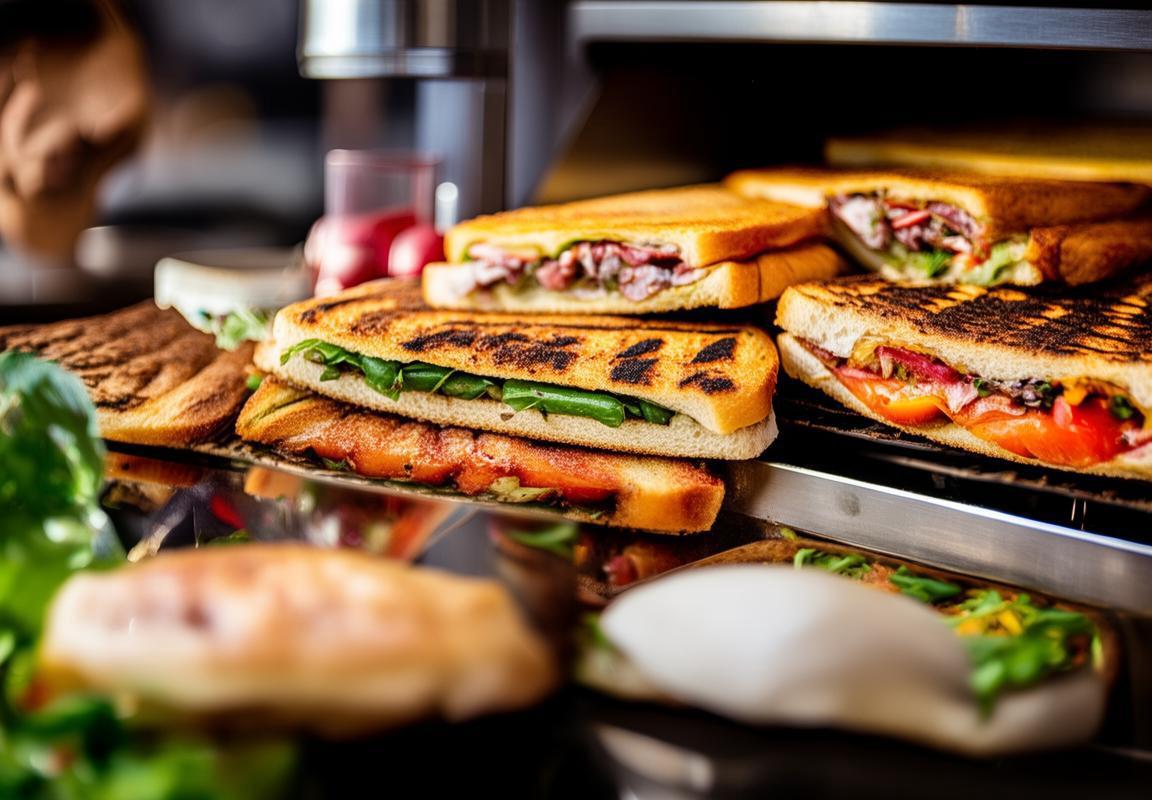
Challenges and Opportunities for Manufacturers in the Next Decade
The commercial panini press market is poised for significant shifts in the next decade, and manufacturers are facing a blend of challenges and opportunities that will shape their strategies and growth paths. Here’s a look at some of the key factors at play:
Innovation in Materials and DesignManufacturers are increasingly focusing on materials that not only enhance the durability and efficiency of panini presses but also cater to the eco-conscious consumer. The use of sustainable materials and energy-efficient designs is becoming more prevalent, offering both a competitive edge and a marketable feature.
Rising Demand for CustomizationAs consumer preferences diversify, there’s a growing trend towards customization. Manufacturers are responding by offering a range of options from adjustable pressure settings to various heating elements, allowing businesses to tailor their panini presses to specific menu items and customer preferences.
Technological IntegrationThe integration of smart technology into commercial panini presses is on the rise. Features like wireless connectivity, app-based controls, and real-time performance monitoring are becoming standard, providing operators with greater convenience and efficiency.
Regulatory ComplianceManufacturers must navigate a complex web of regulations, especially in Europe and the United States, which can vary by region and by the type of commercial establishment. Ensuring compliance with food safety, electrical, and environmental regulations is a challenge but also an opportunity to demonstrate a commitment to quality and safety.
Market Expansion in Emerging RegionsThe demand for commercial panini presses is not limited to established markets. Emerging regions, particularly in Asia and South America, present a significant opportunity for growth. Manufacturers that can adapt their products to local tastes and market conditions will find new avenues for expansion.
E-commerce and Direct-to-Consumer SalesThe rise of e-commerce has opened new channels for manufacturers to reach customers directly. By selling through online platforms, manufacturers can bypass traditional retail channels and build stronger relationships with their end-users, gathering valuable feedback and insights.
Sustainability and Energy EfficiencyWith a growing emphasis on sustainability, manufacturers are under pressure to produce energy-efficient panini presses. This not only reduces operational costs for businesses but also aligns with the broader shift towards environmentally friendly practices.
Competitive Pricing and Value PropositionsCompetitive pricing remains a key challenge for manufacturers. Balancing the need to offer affordable products with the desire to maintain quality and innovation is a delicate balance. However, manufacturers that can offer value propositions beyond just price, such as extended warranties, customer service, and after-sales support, can differentiate themselves in the market.
Adapting to Changing Consumer BehaviorsConsumer behaviors are evolving rapidly, influenced by factors like health consciousness, convenience, and cultural shifts. Manufacturers must stay attuned to these changes and be ready to adapt their product lines and marketing strategies accordingly.
Global Supply Chain ComplexityThe global supply chain is becoming more complex, with manufacturers facing challenges related to raw material availability, shipping costs, and trade policies. Navigating these complexities while maintaining product quality and cost-effectiveness is a significant challenge but also an opportunity to develop more resilient supply chain strategies.
Employee Training and Customer ServiceThe quality of customer service and the skill level of employees handling the panini presses are crucial. Manufacturers need to invest in training programs to ensure that their customers receive the best possible experience, which can lead to repeat business and positive word-of-mouth referrals.
In conclusion, the next decade holds a mix of challenges and opportunities for commercial panini press manufacturers. Those that can innovate, adapt, and maintain a focus on customer satisfaction and regulatory compliance will be well-positioned to thrive in an increasingly competitive and dynamic market.